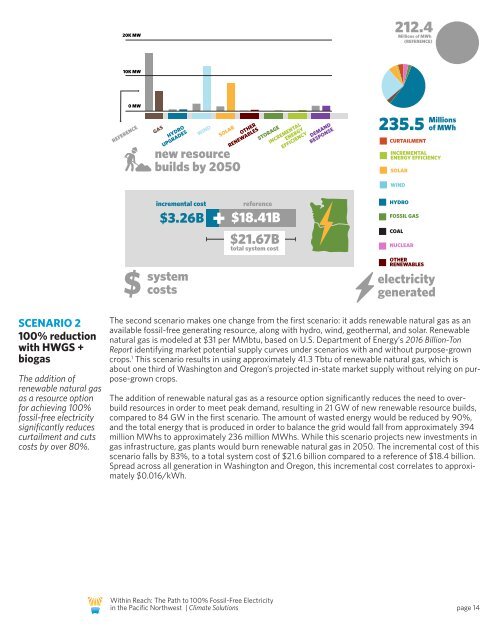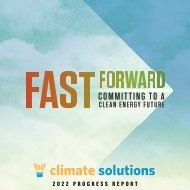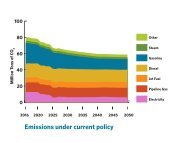within reach - 04
within reach - 04
within reach - 04
You also want an ePaper? Increase the reach of your titles
YUMPU automatically turns print PDFs into web optimized ePapers that Google loves.
20K MW<br />
212.4<br />
Millions of MWh<br />
(REFERENCE)<br />
10K MW<br />
0 MW<br />
REFERENCE<br />
GAS<br />
235.5<br />
CURTAILMENT<br />
SOLAR<br />
WIND<br />
incremental cost<br />
reference<br />
HYDRO<br />
FOSSIL GAS<br />
$3.26B + $18.41B<br />
HYDRO<br />
UPGRADES<br />
new resource<br />
builds by 2050<br />
system<br />
$ costs<br />
WIND<br />
SOLAR<br />
OTHER<br />
RENEWABLES<br />
STORAGE<br />
INCREMENTAL<br />
ENERGY<br />
EFFICIENCY<br />
DEMAND<br />
RESPONSE<br />
$21.67B<br />
total system cost<br />
electricity<br />
generated<br />
Millions<br />
of MWh<br />
INCREMENTAL<br />
ENERGY EFFICIENCY<br />
COAL<br />
NUCLEAR<br />
OTHER<br />
RENEWABLES<br />
SCENARIO 2<br />
100% reduction<br />
with HWGS +<br />
biogas<br />
The addition of<br />
renewable natural gas<br />
as a resource option<br />
for achieving 100%<br />
fossil-free electricity<br />
significantly reduces<br />
curtailment and cuts<br />
costs by over 80%.<br />
The second scenario makes one change from the first scenario: it adds renewable natural gas as an<br />
available fossil-free generating resource, along with hydro, wind, geothermal, and solar. Renewable<br />
natural gas is modeled at $31 per MMbtu, based on U.S. Department of Energy’s 2016 Billion-Ton<br />
Report identifying market potential supply curves under scenarios with and without purpose-grown<br />
crops. 1 This scenario results in using approximately 41.3 Tbtu of renewable natural gas, which is<br />
about one third of Washington and Oregon’s projected in-state market supply without relying on purpose-grown<br />
crops.<br />
The addition of renewable natural gas as a resource option significantly reduces the need to overbuild<br />
resources in order to meet peak demand, resulting in 21 GW of new renewable resource builds,<br />
compared to 84 GW in the first scenario. The amount of wasted energy would be reduced by 90%,<br />
and the total energy that is produced in order to balance the grid would fall from approximately 394<br />
million MWhs to approximately 236 million MWhs. While this scenario projects new investments in<br />
gas infrastructure, gas plants would burn renewable natural gas in 2050. The incremental cost of this<br />
scenario falls by 83%, to a total system cost of $21.6 billion compared to a reference of $18.4 billion.<br />
Spread across all generation in Washington and Oregon, this incremental cost correlates to approximately<br />
$0.016/kWh.<br />
climate solutions<br />
Within Reach: The Path to 100% Fossil-Free Electricity<br />
accelerating in the the Pacific transition to Northwest our clean energy future | Climate Solutions<br />
page 14








